Movie Review: Justice League
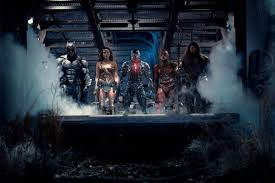
At the conclusion of 2016’s Batman v Superman: Dawn of Justice director Zack Snyder plunged the human world of the DC extended universe into a sense of foreboding and abiding despair. The God-like and omniscient Superman was dead following one of the weirdest and murkiest showdowns in cinematic history to date (blame the incessant CGI as I do) and it was left to the very human Bruce Wayne, aka Batman (Ben Affleck), to try and pick up the pieces. But Batman was not a ‘beacon’ as in Wayne’s own words. He is and remains something of an isolating character; certainly not all-embracing or unifying as Superman is. And, besides all of that, Wayne is an ageing superhero as he knows. When asked by Barry Allen/The Flash (Ezra Miller) what his specific superpowers are, Wayne’s response is suitably laconic – ‘I’m rich.’
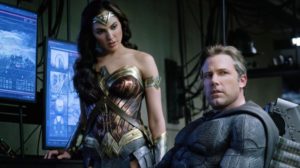
Justice League opens in a similar pall of darkness. The visuals of Snyder and his director of photography Fabian Wagner envisage a world which is joyless and funereal. Discarded papers report the death of Superman; an eternal flame to the man of steel offers little comfort. The filmmakers seem intent on having their characters and supporting players wallow in this misery. Lois Lane (Amy Adams) has returned to work, but admits that she is hardly stretching herself as an investigative reporter. Martha Kent (Diane Lane) meantime has lost her family home to the bank. Without a domicile now, she seems without purpose or drive. Batman himself is riddled with no small smattering of guilt concerning Superman’s demise. Perceiving a new threat from an other-worldly force, he takes it upon himself to seek out those who have special skill sets in the vein of Wonder Woman (Gal Gadot). The subjects of their search respectively are the aforementioned Flash, Cyborg (Ray Fisher) and Aquaman (Jason Momoa).
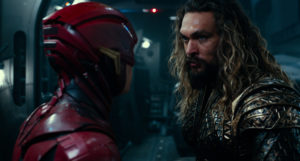
One of the central problems surrounding Justice League is that, for all its early postulating and fusion of disparate characters and storylines, it falls back on a now overly-familiar plot device – the invasion of an otherworldly power which, in this case, takes the form of Steppenwolf (Ciaran Hinds) and his retinue of Parademons. In a backstory provided by Wonder Woman, Steppenwolf had previously tried to conquer the earth and shape it to his own ends by way of power devices known as Mother Boxes. Having suffered a humiliating defeat on that particular occasion, the supervillain is intent on recovering the three boxes and bringing Mother Earth to its knees. For the record, the boxes in question are located in Themyscira (Wonder Woman’s place of origin), Atlantis (where – yes you’ve guessed it – Aquaman hails from) and a secret location which only Cyborg seems to know about. Is any of this so very important in the grand scheme of things you may well ask. Of course not. Justice League is first and foremost a concept film – the concept being to bring these metahumans and superheroes together on screen. The story – as is – serves as a means to this end. It matters not a jot that we can readily guess who will triumph and what certain character will show up for the final CGI-laden denouement. This is a film about setting the scene for the next wave of DCEU installments in the same vein as 2012’s Avengers. The hackneyed plot is merely secondary to this. The rather one-dimensional Steppenwolf is effectively an afterthought.
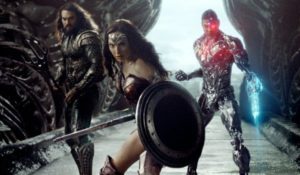
To carp about the excessive use of CGI may seem a futile exercise in terms of where we’ve moved in the gaming world and, by extension, the cinematic universe, but I simply can’t resist one more time, so here it goes: the action sequences in Justice League are as confused and confusing as they were in Batman v Superman and 2013’s Man of Steel. Snyder and his team overpopulate the screen with chaotic movements and gaudy visual flourishes. The human eye simply cannot take such a bombardment – at least mine can’t; perhaps I should have sat up more nights in front of a games console. When characters reach an impasse or face each other down, there is a propensity for them to strike the ground with their weapon of choice. In an emotional context, Diana Prince, aka Wonder Woman, is still grieving the loss of her beloved Steve Trevor following the events of her 2017 stand-alone film. ‘I loved someone once,’ she says. There is some resonance here because those of us who saw that earlier film can remember how superior a piece it was to this present one. More immediate and heartfelt are the scenes which take place between Miller’s Barry Allen and his incarcerated father played by Billy Crudup.
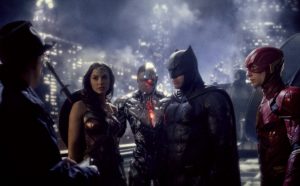
So where lie the strengths of Justice League? Well, for one thing, the lead actors do well by and large and have good support around them with the likes of Crudup, Connie Nielsen, J.K. Simmons and Diane Lane popping up intermittently. Though not quite as effective as she was in Wonder Woman (due no doubt to the reduced screen time here), Gadot fares well as the Amazonian warrior and is accorded one of the best lines of the film when she remarks that she is working with children. As per the 2016 film, Ben Affleck is well cast as an ageing Batman who, in his own words, is barely managing to don the cape as is. The returning Henry Cavill is, mercifully, less stiff than he was in the 2016 film and plays well opposite Adams as Lois Lane. As for the newcomers, Ezra Miller is the undoubted standout as Barry Allen/The Flash and one almost hopes for his own stand-alone film. Jason Momoa also does well as the aquatic one with a proclivity for the hard stuff. Ray Fisher’s Cyborg too is no disgrace, but is not accorded as many quips as Miller or Momoa. There’s a lighter streak coursing through Justice League which makes it a far more tolerable affair than Batman v Superman, but still does not quite put it in the same league as the best of the Marvel films; just consider the recent Thor: Ragnarok in this respect. One suspects that the influence of Joss Whedon (who also pulled the whole thing together after Snyder had to depart earlier in the year for personal reasons) had some bearing in this regard and may have just saved the film from being something of a shambles. With an estimated budget of $300 million, Justice League is one of the costliest productions of all time and there will be many a sweaty palm and perspiring brow as the box office figures come to light and are pored over. A sequel is by no means a foregone conclusion in this regard. If the film fails commercially, or is a monetary disappointment, then expect no small amount of reappraisal. Whilst we are not entirely outraged on this occasion, nor do we hold our breaths for such a future film.
Rating: C-